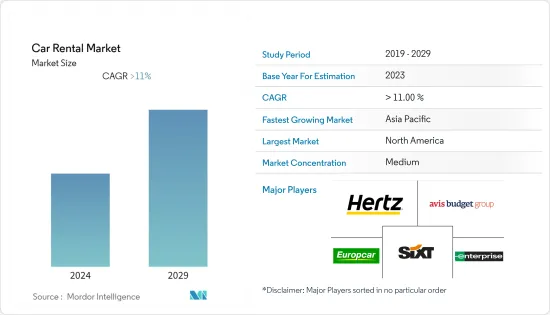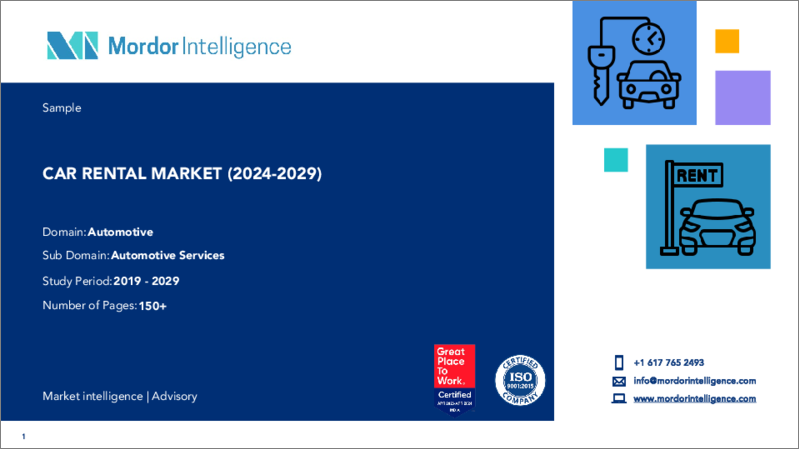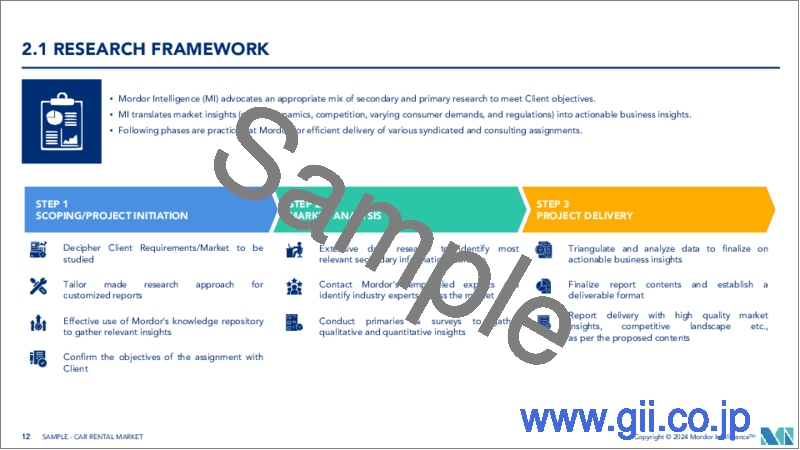|
|
市場調査レポート
商品コード
1519870
レンタカー:市場シェア分析、産業動向と統計、成長予測(2024年~2029年)Car Rental - Market Share Analysis, Industry Trends & Statistics, Growth Forecasts (2024 - 2029) |
||||||
カスタマイズ可能
適宜更新あり
|
|||||||
| レンタカー:市場シェア分析、産業動向と統計、成長予測(2024年~2029年) |
|
出版日: 2024年07月15日
発行: Mordor Intelligence
ページ情報: 英文 120 Pages
納期: 2~3営業日
|
- 全表示
- 概要
- 目次
レンタカー市場規模は2024年に1,321億米ドルと推定され、2029年には2,201億米ドルに達すると予測され、予測期間中(2024~2029年)のCAGRは10.75%以上で成長します。

COVID-19の大流行は、世界中の旅行と観光に大きな影響を与えました。これはレンタカーとライド&シェア輸送セグメントに大きな影響を与えました。パンデミックは企業の格付け引き下げと市場の乱高下をもたらしました。しかし、規制が緩和されると市場は回復力を見せ始めました。
さらに、チップ不足は2021年の世界の自動車生産を妨げ、消費者はレンタカーサービスが提供するメンテナンスや所有のコスト削減を考慮し、レンタカーにシフトしました。
レンタカー市場の前向きな成長軌道は、観光客やビジネス旅行者の増加、健康上の懸念による消費者の嗜好の変化、レンタカー用デジタルプラットフォームの利便性など、さまざまな要因によって後押しされています。
さらに、レジャーと出張を組み合わせる傾向が強まっており、特に若いビジネス旅行者が、スタッフの定着を促進するために企業に採用されています。さらに、各地域で自動車の購入や運転に関する政府の規制が厳しくなっていることも、レンタカー事業の拡大を後押ししています。
オンラインレンタルプラットフォームの増加に伴い、レンタカー業界の人気は高まっています。人口の60%以上がインターネットにアクセスできるという事実は、市場の成長に大きく貢献すると予想されます。
今後数年間も、世界の旅行・観光産業の隆盛により、市場は好調を維持すると予想されます。
レンタカー市場の動向
オンラインレンタカーサービスへの需要の高まりが市場で重要な役割を果たす
情報技術の導入が進むにつれ、レンタカー業界は変貌を遂げ、事業者は顧客に改善されたサービスを提供できるようになっています。これには、最適化された企業および顧客情報管理の活用や、便利なインターネット予約アプリケーションの開発が含まれます。
オンライン予約モデルは、ビーコンと近距離無線通信(NFC)のアプリケーションを特定する最前線にあります。ZipcarやBlaBlaCarのような新しいプレーヤーは、カーシェアリングのような革新的なビジネスモデルを使用し、テレマティクスのような技術を採用することで利益を得ています。ウーバー(Uber)やリフト(Lyft)は、消費者の個人輸送ニーズによりよく対応するため、モバイル技術やデバイスを活用しています。こうした取り組みは、レンタカー業界の破壊に貢献しています。
さらに、オンライン予約は、借りる人の書類の確認、借りる人への車に関する情報の提供、借りた車の特定の場所への乗り捨てや引き取りなどのサービス、契約の電子署名、キャッシュレス取引など、さまざまな目的にも役立っています。さらに、従来はパソコンで行っていたさまざまな活動をスマートフォンで行うユーザーの依存度が高まっていることも、顧客のレンタカー体験を大きく変えるのに役立っています。
Enterprise a CarやEurop Carなどのレンタカー会社も、スペインの観光空港でのレンタカーサービスの運営を拡大することで、この分野での地位を強化しています。主な企業はスペインで強い存在感を示しているもの、最新の発展や積極的な戦略を採用していないため、バンレンタカー市場は低調な需要を目の当たりにしています。
これは、包括的な需要指向のモビリティソリューションの利用可能性の増加によってさらに強化されています。Sixt SE、Uber、Avisなどの業界プレーヤーは、顧客がポートフォリオから簡単に車両を選択し、予約を実行できるモバイルアプリを立ち上げています。
北米が最大市場であり続ける見込み
北米は2024年から2029年にかけても市場の優位性を維持すると予想されます。同地域では、国内外を問わずレジャーや出張の旅行者数が増加していることが、同地域市場の成長に影響を与えている顕著な要因の一つです。
さらに、レンタルサービスに対する消費者の嗜好の継続的な変化や、Avis Budget GroupやEnterprise Rent-a-Carのようなこの地域の著名なサービスプロバイダーの存在は、収益創出の見通しを加速させると予想されます。最近では、サービス事業者による取り組みが活発化したことで、いくつかの都市でこうしたサービスの利用が増加しています。例えば、
は2023年6月、Turoのようなピアツーピアレンタカーを北米に導入する計画を明らかにしました。顧客は1時間単位または1日単位で借りることができ、借りた車を拾った場所で乗り捨てることができます。
加えて、この地域の消費者の間で電気自動車の普及が進み、低排出ガスに対する懸念や意識が高まっていることも、市場を刺激する主な要因のひとつとなっています。さらに、アメリカ人の70%以上が、EVに投資する前にその技術を試乗する方法として、EVのレンタルを好んでいます。
これらすべての要因が相まって、2024年から2029年にかけての同地域の市場成長に弾みがつくと予想されます。
レンタカー業界の概要
レンタカー市場は断片化されており、多数の国際企業や国内企業が世界中で事業を展開しています。主な参入企業には、Enterprise Rent-A-Car、The Hertz Corporation、Sixt SE、Europcar、Avis Budget Groupなどがあります。これらのプレーヤーは、顧客ベースを獲得し、収益性を最大化するためにサービスを強化することに主眼を置いています。コラボレーションも、業界各社が市場での地位を強化するために実施している重要な戦略です。例えば
- 2023年4月、Hertz Global とアトランタ市長のアンドレ・ディケンズは、アトランタにおける電気自動車の導入を加速し、電化の環境的・経済的メリットを拡大することを目的としたPPP、ハーツ・エレクトリフィーズ・アトランタを立ち上げました。
その他の特典:
- エクセル形式の市場予測(ME)シート
- 3ヶ月間のアナリストサポート
目次
第1章 イントロダクション
- 調査の前提条件
- 調査範囲
第2章 調査手法
第3章 エグゼクティブサマリー
第4章 市場力学
- 市場促進要因
- 旅行・観光産業の成長がレンタカー市場を牽引
- 市場抑制要因
- ライドシェアリングサービスの普及が従来のレンタカー市場に課題をもたらす
- ポーターのファイブフォース分析
- 新規参入業者の脅威
- 買い手/消費者の交渉力
- 供給企業の交渉力
- 代替品の脅威
- 競争企業間の敵対関係の強さ
第5章 市場セグメンテーション(市場規模:10億米ドル)
- 予約
- オフラインアクセス
- オンラインアクセス
- アプリケーション
- レジャー/観光
- ビジネス
- エンドユーザー
- セルフ
- ドライバー付き
- 車両タイプ
- エコノミー/バジェットカー
- 高級車
- レンタル期間
- 短期
- 長期
- 地域
- 北米
- 米国
- カナダ
- その他北米
- 欧州
- ドイツ
- 英国
- フランス
- スペイン
- その他欧州
- アジア太平洋
- インド
- 中国
- 日本
- 韓国
- その他アジア太平洋地域
- 世界のその他の地域
- 南米
- 中東・アフリカ
- 北米
第6章 競合情勢
- ベンダー市場シェア
- 企業プロファイル
- Avis Budget Group Inc.
- Hertz Global Holdings Inc.
- Enterprise Holdings Inc.
- Sixt SE
- Fast Rent a Car
- Bettercar Rental
- Europcar Mobility Group
- Shenzhen Topone Car Rental Co. Ltd
- China Auto Rental
- TT Car Transit
- Renault Eurodrive
第7章 市場機会と今後の動向
- EV需要の高まりがレンタカー市場に好機をもたらす
The Car Rental Market size is estimated at USD 132.10 billion in 2024, and is expected to reach USD 220.10 billion by 2029, growing at a CAGR of greater than 10.75% during the forecast period (2024-2029).

The COVID-19 pandemic significantly impacted travel and tourism across the world. This had a huge effect on car rental and the ride-and-share transport segment. The pandemic resulted in company rating downgrades and market volatility. However, the market started showing resilience once the restrictions were eased.
Additionally, the chip shortage hampered global vehicle production in 2021, and consumers shifted toward car rental, considering the cost-saving offered by car rental services in terms of maintenance and ownership.
The positive growth trajectory of the car rental market is fueled by various factors, including the increasing number of tourists and business travelers, changes in consumer preferences due to health concerns, and the convenience of digital platforms for car hire.
Further, the increasing trend of combining leisure with business trips, particularly by younger business travelers, is being adopted by companies to promote staff retention. Additionally, the stringent government regulations on car buying and driving across different regions also favor the expansion of the car rental business.
The popularity of the car rental industry is rising as the number of online rental platforms increases. The fact that more than 60% of the population has access to the internet is anticipated to contribute significantly to the market's growth.
In coming years, the market is expected to continue thriving on a positive track owing to the flourishing travel and tourism industry worldwide.
Car Rental Market Trends
Increasing Demand for Online Car Rental Services to Play a Key Role in the Market
Increased adoption of information technology is transforming the car rental industry and enabling operators to deliver improved services to their customers. This includes the utilization of optimized corporate and customer information management and the development of convenient internet booking applications.
The online booking model is at the forefront of identifying applications for beacons and near-field communications (NFC). Newer players, like Zipcar and BlaBlaCar, are benefiting from using innovative business models such as car-sharing and adopting technologies such as telematics. Uber and Lyft are using mobile technologies and devices to better meet consumers' personal transportation needs. These initiatives are contributing to the disruption of the car rental industry.
Further, online booking also serves a variety of purposes, such as verification of documents of the renter, offering information to the renter regarding the car, services like drop and pick-up of the rented car at a certain place, e-signing contracts, and cashless transactions. Additionally, the rising dependence of users on smartphones to carry out a variety of activities traditionally done by personal computers has significantly helped transform the car rental experience for customers.
Rental companies, such as Enterprise a Car and Europ Car, have also strengthened their position in the sector by expanding their operation of vehicle rental services in Spain's tourist airport. Though key companies have a strong presence in the country, they have not adopted the latest developments or active strategies, so the van rental market is witnessing slow demand.
This is further enhanced by the increased availability of comprehensive demand-oriented mobility solutions. Industry players such as Sixt SE, Uber, and Avis have launched their mobile apps, which allow customers to easily choose vehicles from a portfolio and carry out bookings.
North America is Expected to Remain the Largest Market
North America is expected to retain its dominance in the market between 2024 and 2029. The rising number of leisure and business trips across the region, both locally and internationally, is among the prominent factors influencing the growth of the regional market.
Further, a continuous shift in consumer preference toward rental services and the presence of prominent service providers in the region, like Avis Budget Group and Enterprise Rent-a-Car, are expected to accelerate the revenue generation prospects. Recently, the usage of these services increased in several cities, fueled by increased initiatives by service operators. For instance,
In June 2023, Uber Technologies Inc. disclosed its plan to bring Turo-like peer-to-peer car rental to North America. Customers will be able to rent by the hour or the day and can drop off the rented vehicle wherever it was picked up.
In addition, the rising adoption of electric cars and growing concerns and awareness of lower emissions among consumers in the region are some of the major factors fueling the market. Moreover, over 70% of Americans prefer to rent an EV as a way to test drive the technology before investing in it.
All these factors combined are expected to provide a boost to the positive market growth of the region between 2024 and 2029.
Car Rental Industry Overview
The market is fragmented, with numerous international and domestic companies operating across the world. Key participants include Enterprise Rent-A-Car, The Hertz Corporation, Sixt SE, Europcar, and Avis Budget Group. The primary focus of these players is on enhancing their services to gain a customer base and maximize profitability. Collaboration is another key strategy implemented by industry players to strengthen their positions in the market. For instance,
- In April 2023, Hertz Global and Andre Dickens, the Mayor of Atlanta, launched Hertz Electrifies Atlanta, a PPP aimed at accelerating the adoption of electric vehicles and expanding the environmental and economic benefits of electrification in Atlanta.
Additional Benefits:
- The market estimate (ME) sheet in Excel format
- 3 months of analyst support
TABLE OF CONTENTS
1 INTRODUCTION
- 1.1 Study Assumptions
- 1.2 Scope of the Study
2 RESEARCH METHODOLOGY
3 EXECUTIVE SUMMARY
4 MARKET DYNAMICS
- 4.1 Market Drivers
- 4.1.1 Growing Travel and Tourism Industry is Driving the Car Rental Market
- 4.2 Market Restraints
- 4.2.1 Increasing Popularity of Ride-Sharing Services Pose Challenges for the Conventional Car Rental Market
- 4.3 Porter's Five Forces Analysis
- 4.3.1 Threat of New Entrants
- 4.3.2 Bargaining Power of Buyers/Consumers
- 4.3.3 Bargaining Power of Suppliers
- 4.3.4 Threat of Substitute Products
- 4.3.5 Intensity of Competitive Rivalry
5 MARKET SEGMENTATION (Market Size in Value USD billion)
- 5.1 Booking
- 5.1.1 Offlne Access
- 5.1.2 Online Access
- 5.2 Application
- 5.2.1 Leisure/Tourism
- 5.2.2 Business
- 5.3 End User
- 5.3.1 Self-driven
- 5.3.2 Chauffeur-driven
- 5.4 Vehicle Type
- 5.4.1 Economy/Budget Cars
- 5.4.2 Luxury/Premium Cars
- 5.5 Rental Length
- 5.5.1 Short Term
- 5.5.2 Long Term
- 5.6 Geography
- 5.6.1 North America
- 5.6.1.1 United States
- 5.6.1.2 Canada
- 5.6.1.3 Rest of North America
- 5.6.2 Europe
- 5.6.2.1 Germany
- 5.6.2.2 United Kingdom
- 5.6.2.3 France
- 5.6.2.4 Spain
- 5.6.2.5 Rest of Europe
- 5.6.3 Asia-Pacific
- 5.6.3.1 India
- 5.6.3.2 China
- 5.6.3.3 Japan
- 5.6.3.4 South Korea
- 5.6.3.5 Rest of Asia-Pacific
- 5.6.4 Rest of the World
- 5.6.4.1 South America
- 5.6.4.2 Middle-East and Africa
- 5.6.1 North America
6 COMPETITIVE LANDSCAPE
- 6.1 Vendor Market Share
- 6.2 Company Profiles*
- 6.2.1 Avis Budget Group Inc.
- 6.2.2 Hertz Global Holdings Inc.
- 6.2.3 Enterprise Holdings Inc.
- 6.2.4 Sixt SE
- 6.2.5 Fast Rent a Car
- 6.2.6 Bettercar Rental
- 6.2.7 Europcar Mobility Group
- 6.2.8 Shenzhen Topone Car Rental Co. Ltd
- 6.2.9 China Auto Rental
- 6.2.10 TT Car Transit
- 6.2.11 Renault Eurodrive
7 MARKET OPPORTUNITIES AND FUTURE TRENDS
- 7.1 The Growing Demand for EVs Presents Lucrative Opportunities for the Car Rental Market






